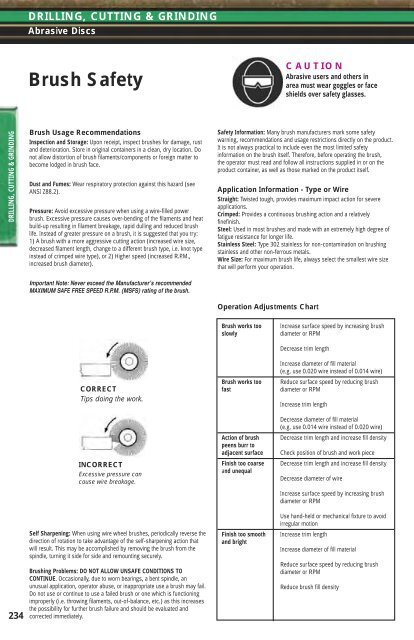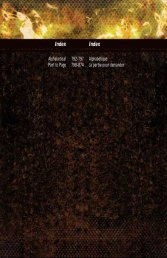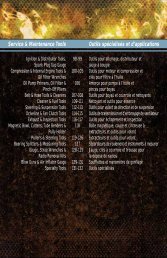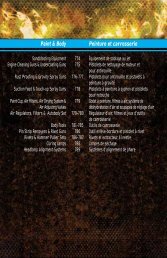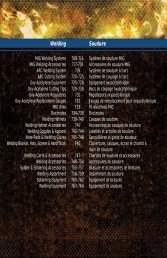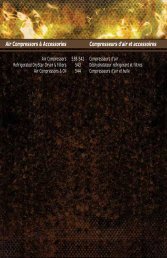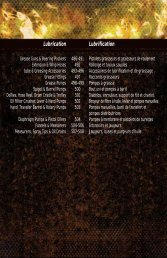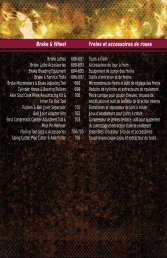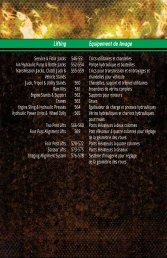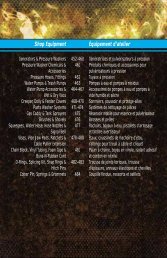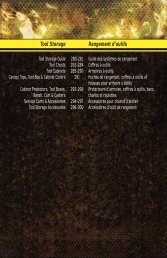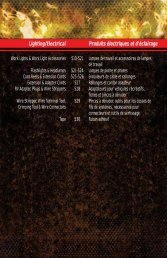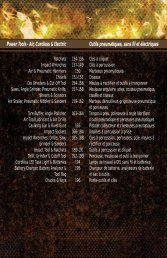Drilling, Cutting & Grinding Perçage, découpage ... - NAPA Auto Parts
Drilling, Cutting & Grinding Perçage, découpage ... - NAPA Auto Parts
Drilling, Cutting & Grinding Perçage, découpage ... - NAPA Auto Parts
You also want an ePaper? Increase the reach of your titles
YUMPU automatically turns print PDFs into web optimized ePapers that Google loves.
DRILLING, CUTTING & GRINDING<br />
Abrasive Discs<br />
Brush Safety<br />
CAUTION<br />
Abrasive users and others in<br />
area must wear goggles or face<br />
shields over safety glasses.<br />
DRILLING, CUTTING & GRINDING<br />
Brush Usage Recommendations<br />
Inspection and Storage: Upon receipt, inspect brushes for damage, rust<br />
and deterioration. Store in original containers in a clean, dry location. Do<br />
not allow distortion of brush filaments/components or foreign matter to<br />
become lodged in brush face.<br />
Dust and Fumes: Wear respiratory protection against this hazard (see<br />
ANSI Z88.2).<br />
Pressure: Avoid excessive pressure when using a wire-filled power<br />
brush. Excessive pressure causes over-bending of the filaments and heat<br />
build-up resulting in filament breakage, rapid dulling and reduced brush<br />
life. Instead of greater pressure on a brush, it is suggested that you try:<br />
1) A brush with a more aggressive cutting action (increased wire size,<br />
decreased filament length, change to a different brush type, i.e. knot type<br />
instead of crimped wire type), or 2) Higher speed (increased R.P.M.,<br />
increased brush diameter).<br />
Safety Information: Many brush manufacturers mark some safety<br />
warning, recommendations and usage restrictions directly on the product.<br />
It is not always practical to include even the most limited safety<br />
information on the brush itself. Therefore, before operating the brush,<br />
the operator must read and follow all instructions supplied in or on the<br />
product container, as well as those marked on the product itself.<br />
Application Information - Type or Wire<br />
Straight: Twisted tough, provides maximum impact action for severe<br />
applications.<br />
Crimped: Provides a continuous brushing action and a relatively<br />
finefinish.<br />
Steel: Used in most brushes and made with an extremely high degree of<br />
fatigue resistance for longer life.<br />
Stainless Steel: Type 302 stainless for non-contamination on brushing<br />
stainless and other non-ferrous metals.<br />
Wire Size: For maximum brush life, always select the smallest wire size<br />
that will perform your operation.<br />
Important Note: Never exceed the Manufacturer’s recommended<br />
MAXIMUM SAFE FREE SPEED R.P.M. (MSFS) rating of the brush.<br />
Operation Adjustments Chart<br />
Brush works too<br />
slowly<br />
Increase surface speed by increasing brush<br />
diameter or RPM<br />
234<br />
CORRECT<br />
Tips doing the work.<br />
INCORRECT<br />
Excessive pressure can<br />
cause wire breakage.<br />
Self Sharpening: When using wire wheel brushes, periodically reverse the<br />
direction of rotation to take advantage of the self-sharpening action that<br />
will result. This may be accomplished by removing the brush from the<br />
spindle, turning it side for side and remounting securely.<br />
Brushing Problems: DO NOT ALLOW UNSAFE CONDITIONS TO<br />
CONTINUE. Occasionally, due to worn bearings, a bent spindle, an<br />
unusual application, operator abuse, or inappropriate use a brush may fail.<br />
Do not use or continue to use a failed brush or one which is functioning<br />
improperly (i.e. throwing filaments, out-of-balance, etc.) as this increases<br />
the possibility for further brush failure and should be evaluated and<br />
corrected immediately.<br />
Brush works too<br />
fast<br />
Action of brush<br />
peens burr to<br />
adjacent surface<br />
Finish too coarse<br />
and unequal<br />
Finish too smooth<br />
and bright<br />
Decrease trim length<br />
Increase diameter of fill material<br />
(e.g. use 0.020 wire instead of 0.014 wire)<br />
Reduce surface speed by reducing brush<br />
diameter or RPM<br />
Increase trim length<br />
Decrease diameter of fill material<br />
(e.g. use 0.014 wire instead of 0.020 wire)<br />
Decrease trim length and increase fill density<br />
Check position of brush and work piece<br />
Decrease trim length and increase fill density<br />
Decrease diameter of wire<br />
Increase surface speed by increasing brush<br />
diameter or RPM<br />
Use hand-held or mechanical fixture to avoid<br />
irregular motion<br />
Increase trim length<br />
Increase diameter of fill material<br />
Reduce surface speed by reducing brush<br />
diameter or RPM<br />
Reduce brush fill density


